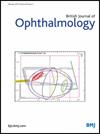Simultaneous inhibition of fibroblast growth factor-2 and vascular endothelial growth factor-a with RC28-E in diabetic macular edema: a phase 2 randomised trial
IF 3.5
2区 医学
Q1 OPHTHALMOLOGY
引用次数: 0
Abstract
Objective To compare different doses and dosing regimens of RC28-E, a novel bispecific antibody that simultaneously binds vascular endothelial growth factor-A (VEGF-A) and fibroblast growth factor-2 (FGF-2), with conbercept in patients with diabetic macular edema (DME). Design Prospective, randomised, active comparator-controlled, open-label, multicentre, phase 2 clinical trial.cente Participants The trial enrolled patients aged 18 years or older with centre-involving DME, best-corrected visual acuity (BCVA) of 73 to 24 Early Treatment Diabetic Retinopathy Study (ETDRS) letters, and central subfield thickness (CST) of 300 µm or more. Methods Patients were assigned randomly to one of five treatment regimens: 1.0 mg RC28-E for three initial monthly doses and then every 8 weeks (1.0mgQ8); 1.0 mg RC28-E for five initial monthly doses and then on a pro re nata (PRN) basis (1.0mgPRN); 2.0 mg RC28-E for three initial monthly doses and then every 8 weeks (2.0mgQ8); 2.0 mg RC28-E for five initial monthly doses and then on a PRN basis (2.0mgPRN); or 0.5 mg conbercept for three initial monthly doses and then on a PRN basis. Assessments were made at baseline and every 4 weeks thereafter. Main outcome measures The primary endpoint was the change in BCVA compared with baseline at 24 and 52 weeks. Secondary endpoints included the change in CST from baseline at 52 weeks; the proportion of patients who gained/lost ≥15 letters, ≥10 letters and >0 letter in BCVA; and the number of injections and safety outcomes. Results The trial enrolled 156 patients. Mean improvements in BCVA in the RC28-E groups at week 24 were 7.1, 11.0, 7.4 and 10.5 letters for 1.0mgQ8, 1.0mgPRN, 2.0mgQ8 and 2.0mgPRN regimens, respectively, versus 9.7 letters for the conbercept group (p=0.146). By week 52, the RC28-E groups exhibited respective mean BCVA enhancements of 5.5, 9.5, 9.2 and 9.7 letters, compared with 8.4 letters of the conbercept group (p=0.469). Mean reductions in CST in the RC28-E groups at week 52 were −163.2 µm, −136.9 µm, −142.5 µm and −153.6 µm, versus −160.7 µm for the conbercept group (p=0.948). The Per Protocol Set analysis indicated that at 24 weeks, the BCVA improvement in the 2.0mgPRN group was significantly greater than that in the conbercept group (14.0 vs 9.8, p=0.019). In patients with poor baseline glycaemic control (HbA1c ≥7.5%), the 2.0mgPRN group showed greater BCVA improvement than the conbercept group (14.4 vs 4.2, p=0.039) at week 52. During the maintenance phase, the 2.0mgPRN group had fewer injections (2.8, 95% CI 1.8 to 3.7) compared with the conbercept group (4.4, 95% CI 3.5 to 5.2). RC28-E was generally well tolerated. The incidence of ocular adverse events in study eyes was comparable between RC28-E groups (22.6% in 1.0mgQ8 group, 26.7% in 1.0mgPRN group, 34.4% in 2.0mgQ8 group, 25.0% in 2.0 mg PRN group) and conbercept group (32.3%). The number of ocular serious adverse events was 1 (1.0mgQ8), 0 (1.0mgPRN), 1 (2.0mgQ8), 2 (2.0mgPRN) and 0 (conbercept). Conclusions Intravitreous RC28-E improved BCVA and CST in eyes with centre-involved DME. Compared with conbercept, the 2.0mgPRN regimen of RC28-E was recommended due to its superior efficacy in improving vision particularly for patients with poor glycaemic control, fewer treatment injections during the maintenance phase and comparable safety profile. Trial registration number [NCT04782115][1]. Data are available upon reasonable request. The data used to support the findings of this study are available from the corresponding author upon request. [1]: /lookup/external-ref?link_type=CLINTRIALGOV&access_num=NCT04782115&atom=%2Fbjophthalmol%2Fearly%2F2025%2F03%2F22%2Fbjo-2024-326006.atomRC28-E同时抑制成纤维细胞生长因子-2和血管内皮生长因子-a治疗糖尿病黄斑水肿:一项2期随机试验
目的比较不同剂量和给药方案的RC28-E,一种同时结合血管内皮生长因子- a (VEGF-A)和成纤维细胞生长因子-2 (FGF-2)的新型双特异性抗体,对糖尿病性黄斑水肿(DME)患者的治疗效果。前瞻性、随机、主动对照、开放标签、多中心、2期临床试验。该试验招募了年龄在18岁或以上的患者,伴有中心介入性DME,最佳矫正视力(BCVA)为73至24个早期治疗糖尿病视网膜病变研究(ETDRS)字母,中心亚场厚度(CST)为300 μ m或更高。方法将患者随机分配到五种治疗方案中的一种:1.0mg RC28-E,最初三个月给药,然后每8周给药(1.0 mgq8);1.0mg RC28-E,最初每月给药5次,然后按比例(PRN)给药(1.0mgPRN);2.0mg RC28-E,最初每月给药3次,然后每8周给药一次(2.0 mgq8);2.0mg RC28-E最初每月给药5次,然后按PRN (2.0mgPRN)计算;或0.5毫克的概念,最初每月服用三次,然后按PRN计算。在基线和之后每4周进行一次评估。主要终点是24周和52周时BCVA与基线相比的变化。次要终点包括52周时CST从基线的变化;BCVA增加/减少≥15个字母、≥10个字母和>个字母的患者比例;注射次数和安全性结果。结果试验入组156例患者。1.0mgQ8、1.0mgPRN、2.0mgQ8和2.0mgPRN方案的RC28-E组在第24周的BCVA平均改善分别为7.1、11.0、7.4和10.5个字母,而概念组为9.7个字母(p=0.146)。到第52周,RC28-E组分别表现出5.5、9.5、9.2和9.7个字母的平均BCVA增强,而concept组为8.4个字母(p=0.469)。第52周时,RC28-E组的平均CST减少量为- 163.2µm, - 136.9µm, - 142.5µm和- 153.6µm,而concept组为- 160.7µm (p=0.948)。Per Protocol Set分析显示,在24周时,2.0mgPRN组的BCVA改善显著大于concept组(14.0 vs 9.8, p=0.019)。在基线血糖控制较差(HbA1c≥7.5%)的患者中,2.0mgPRN组在第52周的BCVA改善程度高于概念组(14.4 vs 4.2, p=0.039)。在维持期,2.0mgPRN组的注射次数(2.8次,95% CI 1.8 ~ 3.7)少于概念组(4.4次,95% CI 3.5 ~ 5.2)。RC28-E总体耐受良好。研究眼的眼部不良事件发生率在RC28-E组(1.0mgQ8组22.6%,1.0mgPRN组26.7%,2.0 mgq8组34.4%,2.0mg PRN组25.0%)和conberconcept组(32.3%)之间具有可比性。眼部严重不良事件数分别为1例(1.0mgQ8)、0例(1.0mgPRN)、1例(2.0mgQ8)、2例(2.0mgPRN)和0例(概念)。结论玻璃体内注射RC28-E可改善中心受累二甲醚眼的BCVA和CST。与concept相比,推荐采用RC28-E的2.0mgPRN方案,因为其改善视力的效果更好,特别是对于血糖控制不佳的患者,维持期治疗注射量更少,安全性也相当。试验注册号[NCT04782115][1]。如有合理要求,可提供资料。用于支持本研究结果的数据可应要求从通讯作者处获得。[1]: /查找/ external-ref ? link_type = CLINTRIALGOV&access_num = NCT04782115&atom = % 2 fbjophthalmol % 2恐惧% 2 f2025 % 2 f03 % 2——f22 % 2 fbjo - 2024 - 326006. -原子
本文章由计算机程序翻译,如有差异,请以英文原文为准。
求助全文
约1分钟内获得全文
求助全文
来源期刊
CiteScore
10.30
自引率
2.40%
发文量
213
审稿时长
3-6 weeks
期刊介绍:
The British Journal of Ophthalmology (BJO) is an international peer-reviewed journal for ophthalmologists and visual science specialists. BJO publishes clinical investigations, clinical observations, and clinically relevant laboratory investigations related to ophthalmology. It also provides major reviews and also publishes manuscripts covering regional issues in a global context.

 求助内容:
求助内容: 应助结果提醒方式:
应助结果提醒方式:


